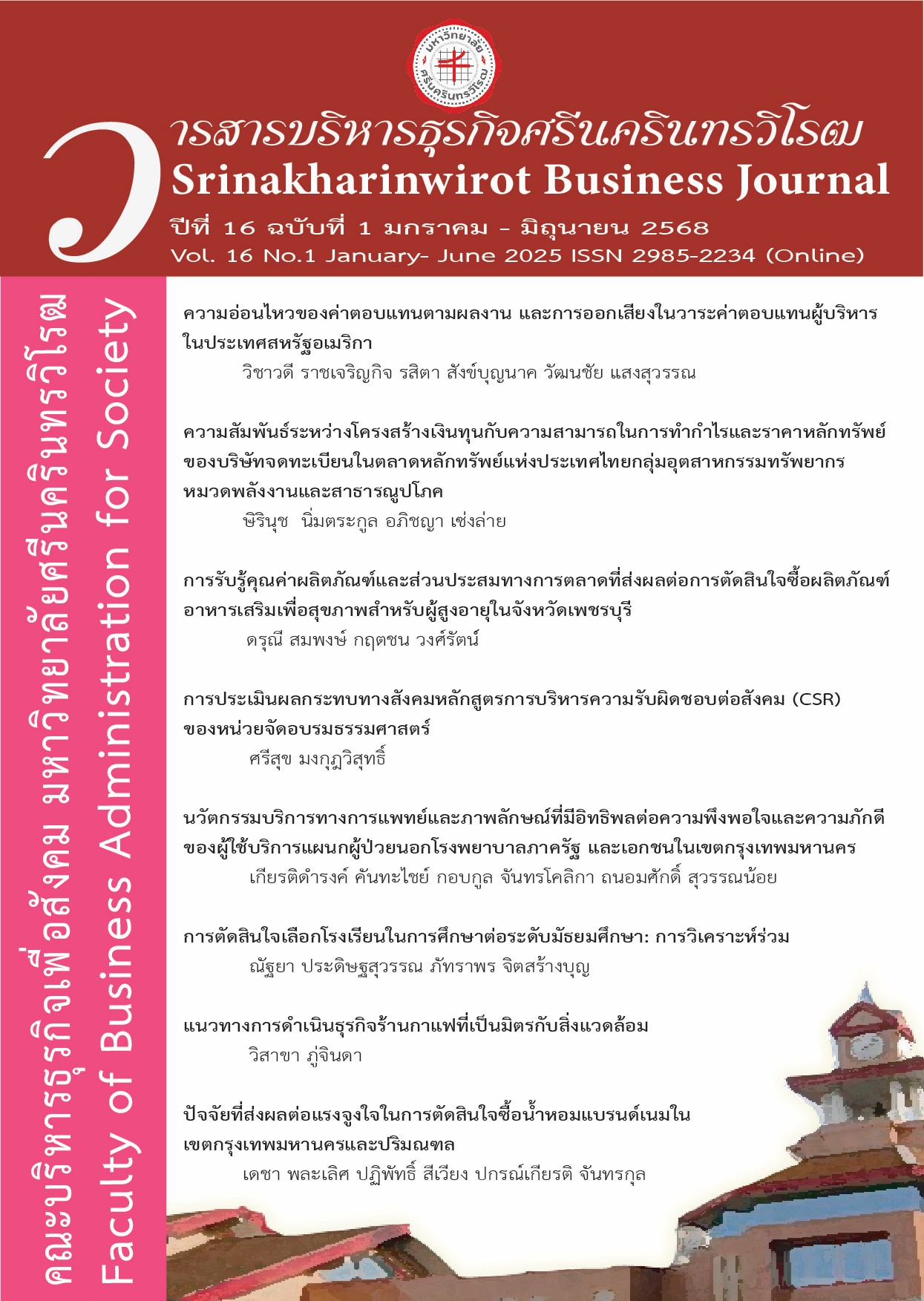PRODUCT VALUE PERCEIVED AND MARKETING MIX AFFECTING PURCHASING DECISION OF HEALTH SUPPLEMENT PRODUCTS FOR THE ELDERLY IN PHETCHABURI PROVINCE
Keywords:
Product value perceived, Marketing mix, Health supplement products, Purchasing decision, ElderlyAbstract
This research aimed to study 1) the perceived product value, marketing mix, purchasing decision 2) the perceived product value affecting purchasing decision health supplement products for the elderly in Phetchaburi Province, and 3) the marketing mix affecting purchasing decision health supplement products for the elderly in Phetchaburi Province. The sample group consisted of 398 elderly individuals aged 60 years in Phetchaburi province. They were selected by using accidental sampling method. The research instrument was a questionnaire with a reliability of 0.96. The data was analyzed with statistics for percentage, mean, standard deviation, and multiple regression analysis.
The research results were as follows:
- The overall perceived product value factor was at a high average level. When considering each aspect, it was found that the epistemic value had the highest average, followed by the emotional value, conditional value, social value, and functional value, respectively. The overall marketing mix factor was at a high average level. When considering each aspect, it was found that the product had the highest average, followed by the place, promotion and price, respectively. The overall purchasing decision factor was at a high average level.
- The perceived product value affected purchasing decision health supplement products for the elderly in Phetchaburi Province, namely, epistemic value(xepi), functional value(xfun), and conditional value(xcon). The predictive efficiency was at 50percent and the equation of prediction was total= 0.977 + 0.494(xepi) + 0.198(xfun) + 0.166(xcon)
- The marketing mix affected purchasing decision health supplement products for the elderly in Phetchaburi Province namely, price (xpri), promotion (xpromo), and product (xpro). The predictive efficiency was at 40 percent and the equation of prediction was total= 0.692 + 0.355(xpri) + 0.265(xpromo) + 0.164(xpro)
References
กรมกิจการผู้สูงอายุ. (2566, เมษายน). รายงานสถานการณ์สังคม ประจำปี 2565. https://www.dop.go.th/download/implementation/th1685081773-1473_0.pdf
กรมกิจการผู้สูงอายุ. (2567, ธันวาคม). สถิติผู้สูงอายุ. https://www.dop.go.th/th/know/side/1/1/2449
นพพร บัวอินทร์ และ กฤชเชาว์ นันทสุดแสวง. (2562). ส่วนผสมทางการตลาดที่ีมีอิทธิพลต่อพฤติกรรมการเลือกซื้อผลิตภัณฑ์เสริมอาหารเพื่อสุขภาพของผู้บริโภคในจังหวัดระยอง. วารสารมหาวิทยาลัยศิลปากร, 39(6), 72-84. https://so05.tci-thaijo.org/index.php/sujthai/article/view/182458/154955
นภวรรณ คณานุรักษ์. (2563). พฤติกรรมผู้บริโภค (พิมพ์ครั้งที่ 2). กรีนแอปเปิ้ล กราฟฟิค พริ้นติ้ง.
นาฏอนงค์ นามบุดดี. (2558). อนาคตของผลิตภัณฑ์เสริมอาหาร และการปรับกลยุทธ์การตลาดในไทย. วารสารสังคมศาสตร์ มหาวิทยาลัยศรีนครินทรวิโรฒ, 18(1), 353-374. https://ejournals.swu.ac.th/index.php/JOS/article/view/7043/6557
ประกาศกระทรวงสาธารณสุข เรื่อง ผลิตภัณฑ์เสริมอาหาร. (2548). ราชกิจจานุเบกษา. ฉบับที่ 293, หน้า 1-9.
พระราชบัญญัติผู้สูงอายุ พ.ศ. 2546. (2546). ราชกิจจานุเบกษา. เล่ม 127 ตอนที่ 56 ก, หน้า 3
พิมพ์ชนก บุนนาค. (2561). การรับรู้คุณค่าผลิตภัณฑ์เสริมอาหารควบคุมน้ำหนักตามบุคลิกภาพที่แตกต่างกันของเจเนอเรชั่นวาย [การค้นคว้าอิสระปริญญามหาบัณฑิต ไม่ได้ตีพิมพ์]. มหาวิทยาลัยเชียงใหม่.
พัชณี มาเสถียร. (2564). การรับรู้คุณค่าด้านผลิตภัณฑ์และทัศนคติที่ส่งผลต่อการตัดสินใจซื้อผลิตภัณฑ์เครื่องดื่มเสริมอาหารที่ใช้สารให้ความหวานแทนน้ำตาลของผู้บริโภค [การค้นคว้าอิสระปริญญามหาบัณฑิต ไม่ได้ตีพิมพ์]. มหาวิทยาลัยมหิดล.
พัชรชานนท์ อธิก้องเกียรติ, และ สวรส ศรีสุตโต. (2562). การรับรู้คุณค่าและทัศนคติของผู้บริโภคด้านส่วนประสมทางการตลาดที่ส่งผลต่อกระบวนการตัดสินใจซื้อผลิตภัณฑ์อาหารเสริมคอลลาเจน ในเขตกรุงเทพมหานคร [การค้นคว้าอิสระปริญญามหาบัณฑิต ไม่ได้ตีพิมพ์]. มหาวิทยาลัยหอการค้าไทย.
โรงพยาบาลเปาโลโชคชัย 4. (2566, 19 พฤษภาคม). เมื่อสูงวัย ต้องให้ความสำคัญกับเรื่องสุขภาพ. https://www.paolohospital.com/th-TH/chokchai4/Article/Details/เมื่อสูงวัย-ต้องให้ความสำคัญกับเรื่องสุขภาพ
วิเชษฐ์ ลีลามานิตย์. (2558). การใช้วิตามินและอาหารเสริมในผู้สูงอายุ. ค้นเมื่อ 21 ธันวาคม 2566, จาก http://www.pharmacy.mahidol.ac.th/knowledge/files/0253.pdf
สิทธิชัย โจมสว่าง. (2563). การศึกษาโมเดลความสัมพันธ์เชิงสาเหตุที่ส่งผลต่อการตัดสินใจซื้อผลิตภัณฑ์เสริมอาหารของผู้สูงอายุในเขตกรุงเทพมหานคร [วิทยานิพนธ์ปริญญามหาบัณฑิต ไม่ได้ตีพิมพ์]. มหาวิทยาลัยเทคโนโลยีราชมงคลกรุงเทพ.
อัครภณ เศวตกมล. (2564). พฤตกรรมการตัดสินใจในการบริโภคผลิตภัณฑ์เสริมอาหารของผู้บริโภค ในเขตดอนเมืองกรุงเทพมหานคร [การค้นคว้าอิสระปริญญามหาบัณฑิต ไม่ได้ตีพิมพ์]. มหาวิทยาลัยเกริก.
Euromonitor International. (2024, August). Health and Wellness in the US. https://www.euromonitor.com/health-and-wellness-in-the-us/report
Honea, H., & Horsky, S. (2012). The power of plain: Intensifying product experience with neutral aesthetic context. Marketing Letters, 23(11), 223-235. https://doi.org/10.1007/s11002-011-9149-y
International Food Information Council. (2020). Food & Health Survey. https://foodinsight.org/2020-food-and-health-survey/
Jiyoung, H. (2016). Organic food as self-presentation: The role of psychological motivation in older consumers' purchase intention of organic food. Journal of Retailing and Consumer Services, 28(1), 281–287. https://doi.org/10.1016/j.jretconser.2015.01.007
Ledden, L., Kalafatis, S.P., Samouel, P., (2007). The relationship between personal values and perceived value of education. Journal of Business Research. 60, 965–974. https://doi.org/10.1016/j.jbusres.2007.01.021
Likert, R. N. (1970). A technique for the measurement of attitude. Attitude Measurement. Ronal McNally & Company.
McCarthy, E. J. (1960). Basic Marketing: A Managerial Approach. R. D. Irwin.
Park, J., & Ha, S. (2016). Co-creation of service recovery: Utilitarian and hedonic value and post-recovery responses. Journal of Retailing and Consumer Services, 28(January 2016), 310-316.
https://doi.org/10.1016/j.jretconser.2015.01.00
Schiffman, L. G. & Kanuk, L. L. (2007). Consumer behavior. (9th ed). Prentice-Hall.
Sheth, J. N., Newman, B. I., & Gross, B. L. (1991). Why We Buy What We Buy: A Theory of Consumption Values. Journal of Business Research, 22(2),159-170. DOI:10.1016/0148-2963(91)90050-8
Smith, J. B., & Colgate, M. (2007). Customer value creation: a practical framework. Journal of Marketing Theory and Practice, 15, 7-23. https://doi.org/10.2753/MTP1069-6679150101
Statista (2021). Trust in Brands. https://www.statista.com/search/?q=Trust+in+Brands+&p=1
Sweeney, J.C., & Soutar, G.N. (2001). Consumer Perceived Value: The Development of a Multiple Item Scale. Journal of Retailing, 77(2), 203-220. https://doi.org/10.1016/S0022-4359(01)00041-0
Wang, E. (2013). The influence of visual packaging design on perceived food product quality, value, and brand preference. International Journal of Retail & Distribution Management, 41(10), 805-816. https://doi.org/10.1108/IJRDM-12-2012-0113
Wang, X., Lin, X., & Spencer, M. K. (2019). Exploring the effects of extrinsic cues on consumers' perceived value and purchase intention of dietary supplements. British Food Journal, 45, 163-75. https://doi.org/10.1016/j.ijinfomgt.2018.11.010
Yamane, T. (1976). Statistics: An introductory analysis. Harper and Row.
Zanroo, (2023). กลยุทธ์ทางการตลาด 4P เรื่องที่เจ้าของธุรกิจออนไลน์ต้องรู้!. Retrieved December 15, 2023 from https://enterprise.zanroo.com/post/all-about-4p-marketing-strategy
Downloads
Published
How to Cite
Issue
Section
License
Copyright (c) 2025 Srinakharinwirot Business Journal

This work is licensed under a Creative Commons Attribution-NonCommercial-ShareAlike 4.0 International License.
วารสารบริหารธุรกิจศรีนครินทรวิโรฒ ยินดีรับบทความวิจัยและบทความทางวิชาการด้านบริหารธุรกิจ เพื่อพิจารณาตีพิมพ์เผยแพร่ในวารสาร ซึ่งทัศนะและข้อคิดเห็นใดๆ ในวารสารฯ ถือเป็นความคิดเห็นและความรับผิดชอบโดยตรงของผู้เขียน มิใช่เป็นความคิดเห็นและความรับผิดชอบใดๆ ของคณะบริหารธุรกิจเพื่อสังคม มหาวิทยาลัยศรีนครินทรวิโรฒ ผู้ประสงค์จะนำบทความหรือบทวิจารณ์ใดๆ ไปเผยแพร่ จะต้องได้รับการอนุญาตจากวารสารเป็นลายลักษณ์อักษร ลิขสิทธิ์บทความที่เผยแพร่ทั้งหมดเป็นของวารสารบริหารธุรกิจศรีนครินทรวิโรฒ






